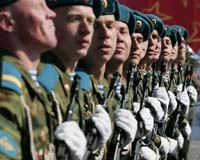| . |  |
. |
Washington (UPI) May 15, 2009 The North Atlantic Treaty Organization for 40 years through the Cold War focused on its mission of being able to fight a defensive war in Europe if necessary against the military forces of the Soviet Union and, after 1955, of the Soviet-led Warsaw Pact. In the nearly two decades since the Soviet Union started to disintegrate in 1989, NATO's national leaders and defense ministers have seen its prime purpose as ensuring internal and regional stability among and between its member states. There have also been bold calls for NATO to act as a regional policeman, and the alliance is now projecting its forces -- weakly and ineptly -- as far away as Afghanistan. But the one thing alliance leaders and planners never thought their organization would ever have to do was to actually fight a conventional war, ever again, let alone against Russia -- until last August. The Russian invasion of the former Soviet republic of Georgia in the Caucasus in August punctured all the dreams and speeches about a kinder, gentler NATO like a bolt of lightning hitting the airship Hindenburg. But the lessons and implications of that military operation have yet to sink into the consciousness of NATO planners at alliance headquarters in Brussels or into the military staffs and defense ministries of its main European member states. Georgia of course was not a member of NATO. If it had been, the famous Article 5 of the 1949 North Atlantic Treaty, also known as the Washington Treaty, would have been invoked when Russian forces crossed into the forested and mountainous remote little country in the Caucasus on Aug. 8, and the United States and all its European allies would have been obligated to rush military forces to Tbilisi, even if that set off a conventional war with Russia that could have even gone nuclear. As it was, the Bush administration had pushed hard at the NATO summit in Bucharest, Romania, a few months earlier to try to win approval from its allies to let Georgia join the alliance. Led by Germany and France, many alliance member states refused to do so. Also, the U.S. government had given the Georgians hundreds of millions of dollars worth of advanced American military equipment. Almost all of it fell easily into the hands of the Russian army. Bush administration policymakers refused to believe until it actually happened that the Russian army would in fact physically invade Georgia to discredit President Mikheil Saakashvili. Now history is repeating itself. Russia has been building up its conventional forces again in South Ossetia and Abkhazia, the two secessionist enclaves of Georgia that Moscow recognizes as independent republics. The Russians are also furious that U.S. President Barack Obama and other NATO leaders have approved NATO military maneuvers in Georgia this month as a gesture of support for the embattled Saakashvili. But Russian leaders see this as another sign that NATO leaders are determined to further encroach on Russian security and interests in its own back yard. Georgia, after all, was part of the Russian and Soviet states from 1800 to the end of 1991 -- a longer period of time than more than half the states of the United States have existed. Since the Georgia mini-war, the Russian government has openly publicized its ambitious plans to modernize its armed forces. And as we have documented in our companion BMD Watch and BMD Focus columns, the Kremlin has also announced it will sell its S-400 anti-aircraft and anti-missile interceptor system, the most advanced anti-ballistic missile system in the world, to its ally and western neighbor Belarus. In practice, this means that the Russian air force is prepared to deny NATO and the U.S. Air Force freedom to operate their air superiority over the Belarus-Poland region that is the key invasion route between Eastern and Western Europe. None of this makes the prospect of a conventional war between Russia and NATO inevitable, but such a conflict is no longer inconceivable either. Part 5: Russian capabilities and challenges to NATO in local conflicts Share This Article With Planet Earth
Related Links Learn about the Superpowers of the 21st Century at SpaceWar.com Learn about nuclear weapons doctrine and defense at SpaceWar.com
 Russia Approves New Defense Strategy
Russia Approves New Defense StrategyWashington (UPI) May 14, 2009 Russia has approved a new national-security strategy that, while short in detail, visualizes more than a decade of suspicious confrontation with the United States and its NATO allies. The new doctrine, unveiled Wednesday by President Dmitry Medvedev, appears to have been greatly influenced by Russian anger over U.S. President Barack Obama's continued support for the former Soviet republ ... read more |
|
| The content herein, unless otherwise known to be public domain, are Copyright 1995-2009 - SpaceDaily. AFP and UPI Wire Stories are copyright Agence France-Presse and United Press International. ESA Portal Reports are copyright European Space Agency. All NASA sourced material is public domain. Additional copyrights may apply in whole or part to other bona fide parties. Advertising does not imply endorsement,agreement or approval of any opinions, statements or information provided by SpaceDaily on any Web page published or hosted by SpaceDaily. Privacy Statement |